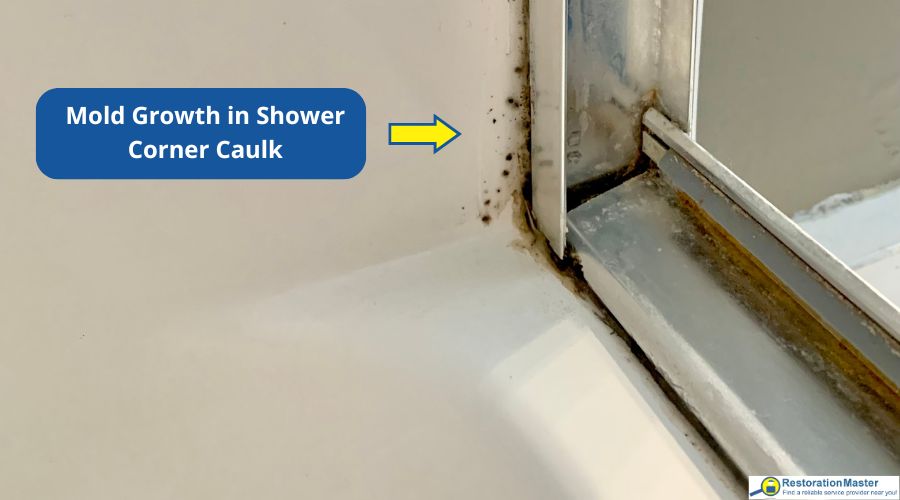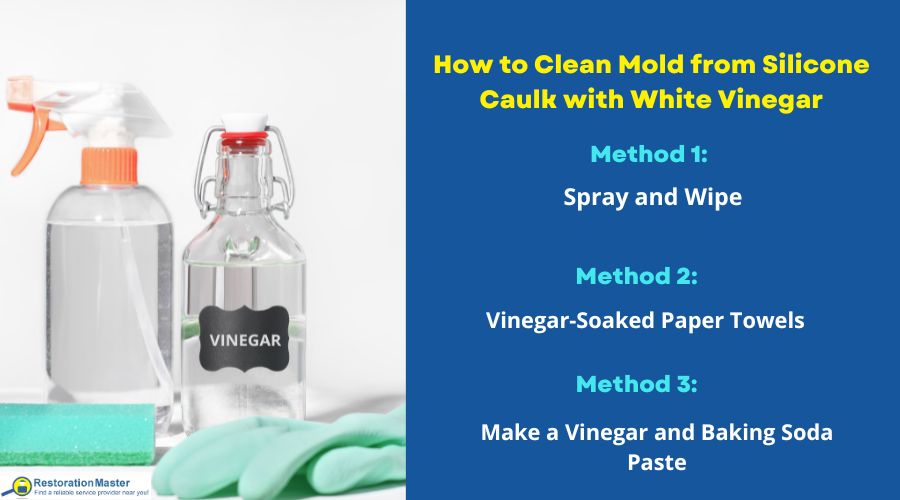How to Remove Mold from Silicone Caulk Without Bleach

Scrubbing the shower clean on a regular basis may not always deter moldMold is a type of fungus that grows in damp or humid conditi... More. The sporesSpores are microscopic reproductive units of fungi or mold t... More thrive in humid, moist spaces, making the bathroom an enticing place to be. Although silicone caulk might become covered in moldMold is a type of fungus that grows in damp or humid conditi... More, the homeowner can take steps to safely remove it.
MoldMold is a type of fungus that grows in damp or humid conditi... More sporesSpores are microscopic reproductive units of fungi or mold t... More are abundant in the natural environment. Airborne sporesSpores are microscopic reproductive units of fungi or mold t... More can meander into a building, land in a hospitable area and multiply rapidly. MoldMold is a type of fungus that grows in damp or humid conditi... More thrives in places that contain three nutrient sources: water, humidityHumidity is the amount of moisture or water vapor present in... More, and darkness. The bathroom, naturally, can be a breeding ground for moldMold is a type of fungus that grows in damp or humid conditi... More.
Silicone caulk is typically found in bathrooms between the spaces of the sink, countertop, shower, wall, and tub. The white material can harbor black moldMold is a type of fungus that grows in damp or humid conditi... More sporesSpores are microscopic reproductive units of fungi or mold t... More, because these areas of the bathroom are difficult to keep clean and dry on a consistent basis.
Why avoid bleach to clean mold?

A homeowner may decide to clean the bathroom moldMold is a type of fungus that grows in damp or humid conditi... More with bleach. After all, bleach is heavily promoted as a product that kills mold. However, using bleach is not always the best idea. Bleach is a harsh substance that can negatively affect the immediate environment in which it is used.
Chlorine, for example, creates harmful fumes that pollute the air. Bleach is also classified as a toxic substance that is potentially dangerous to humans and pets. While a powerful disinfectantA disinfectant is a chemical substance used to kill or inact... More, bleach does not kill all moldMold is a type of fungus that grows in damp or humid conditi... More, especially those growing on porousPorous describes a material that contains small openings or ... More and semi-porous surfaces.
While caulking is not porousPorous describes a material that contains small openings or ... More at first, over time, it can become permeable. Cleaning the caulk with chlorine bleach will fail to work in the long run, since the bleach cannot penetrate deep into the porousPorous describes a material that contains small openings or ... More material where the roots of moldMold is a type of fungus that grows in damp or humid conditi... More sporesSpores are microscopic reproductive units of fungi or mold t... More take hold.
How is mold removed without bleach?

Instead, the best way to clean moldMold is a type of fungus that grows in damp or humid conditi... More from silicone caulk is with the use of distilled white vinegar. Cleaning moldy caulk with this household staple is the most environmentally friendly and healthiest route. White vinegar is an effective cleaning agent, removing all moldMold is a type of fungus that grows in damp or humid conditi... More.
Simply spray the white vinegar onto the moldy silicone caulk and wipe it off. An alternate and equally effective mold removal tactic is to create a paste consisting of white vinegar and baking soda. Mix together one cup white vinegar and 2 to 3 teaspoons of baking soda.
Rub a thick layer of paste onto the silicone caulk. Allow the paste to sit for five minutes. Using a stiff-bristled brush, scrub the paste into the moldy caulk. Then clean off the paste and moldMold is a type of fungus that grows in damp or humid conditi... More with a rinse of cool water. If the moldMold is a type of fungus that grows in damp or humid conditi... More remains, repeat the abovementioned steps.
Another mold-removal strategy is to use paper towels soaked in vinegar. Roll the paper into a twist, lay it over the moldy silicone caulk and spray with vinegar. Allow the vinegar to soak in. Keep the paper in place for a few hours, then remove it along with the moldMold is a type of fungus that grows in damp or humid conditi... More.
How is mold in the bathroom prevented?
While moldMold is a type of fungus that grows in damp or humid conditi... More in the bathroom and on silicone caulk are likely, a homeowner can prevent moldMold is a type of fungus that grows in damp or humid conditi... More by keeping the area as clean and dry as possible. Since moldMold is a type of fungus that grows in damp or humid conditi... More thrives in moist conditions, turn on the exhaust fan while showering and for 10 to 15 minutes afterward.
The exhaust fan works to eliminate excess moisture, one of the primary nutrients for moldMold is a type of fungus that grows in damp or humid conditi... More sporesSpores are microscopic reproductive units of fungi or mold t... More. A homeowner who does not have a fan installed in the bathroom should strongly consider investing one. Homes in areas with humidityHumidity is the amount of moisture or water vapor present in... More issues especially should have exhaust fans in the bathroom.
A second moisture-control tip is to squeegeeA squeegee is a tool with a flat rubber blade used to remove... More the glass shower door. Especially when humidityHumidity is the amount of moisture or water vapor present in... More issues are prevalent, also wipe down the silicone caulk, tile, countertops, and sink. These steps control the moisture level in the bathroom while helping to keep the areas clean.
Spraying the silicone caulk daily with vinegar also keeps moldMold is a type of fungus that grows in damp or humid conditi... More at bay. If the moldMold is a type of fungus that grows in damp or humid conditi... More continues to appear despite daily spritzes of vinegar, consider applying a shower spray. A range of different sprays are available for either daily or weekly use.
Wash the bathroom towels frequently to avoid giving moldMold is a type of fungus that grows in damp or humid conditi... More a place to grow. Remove lingering moisture from the bathroom by opening a window or running a dehumidifierA dehumidifier is a device that removes excess moisture from... More. Certain houseplants, too, can remove humidityHumidity is the amount of moisture or water vapor present in... More, so consider placing one in the bathroom.
Most importantly, any plumbing issues should be repaired right away to keep moldMold is a type of fungus that grows in damp or humid conditi... More from appearing. Pools of water on the bathroom floor are signs of a plumbing problem. Call in a professional plumber to assess the space for leaks, including the areas behind the wall.
MoldMold is a type of fungus that grows in damp or humid conditi... More sporesSpores are microscopic reproductive units of fungi or mold t... More growing on the silicone caulk or anywhere else in the home should be dealt with swiftly. Homeowners who are unable to safely remove the moldMold is a type of fungus that grows in damp or humid conditi... More or stumble upon an extensive infestation should call mold remediation experts.

MoldMold is a type of fungus that grows in damp or humid conditi... More removal companies are staffed with a team of certified technicians who are experienced in eliminating moldMold is a type of fungus that grows in damp or humid conditi... More growth of all sizes. Whether the moldMold is a type of fungus that grows in damp or humid conditi... More grows behind the wall, under carpets, or on other hidden areas, specialists will find it using advanced detection equipment and remove it.
Technicians remove moldMold is a type of fungus that grows in damp or humid conditi... More colonies and also discard materials that have been contaminated by the unwanted growth. Damaged areas are rebuilt by skilled crews, and your home or commercial building is quickly returned to its original condition.
Aside from swift moldMold is a type of fungus that grows in damp or humid conditi... More removal, another important task mold specialists perform is the repairRepair is the act of fixing or restoring damaged property, m... More of the moisture source. Without water, moldMold is a type of fungus that grows in damp or humid conditi... More cannot survive. Technicians will pinpoint the leak, fix it, and prevent the moldMold is a type of fungus that grows in damp or humid conditi... More infestation from returning even after the mold remediationMold remediation is the process of identifying, removing, an... More is completed.
Musty odors can permeateTo permeate is to pass through or spread throughout a materi... More the building as a result of the moldMold is a type of fungus that grows in damp or humid conditi... More growth. Remediation crews deodorize the property to ensure the air quality is optimal and the occupants remain safe from the harmful effects of breathing in moldMold is a type of fungus that grows in damp or humid conditi... More sporesSpores are microscopic reproductive units of fungi or mold t... More.












